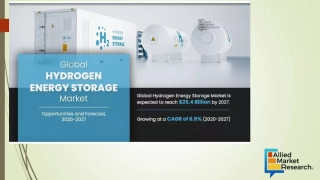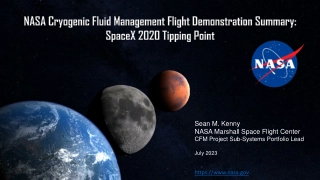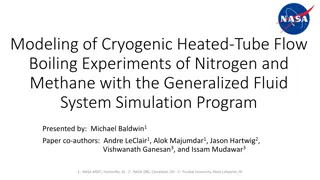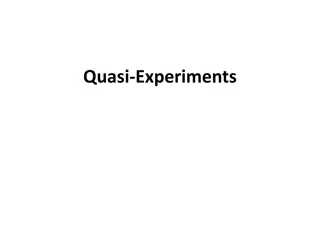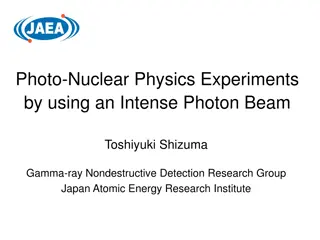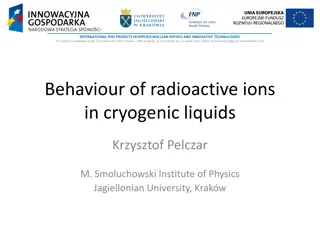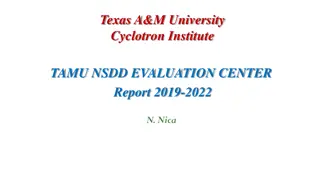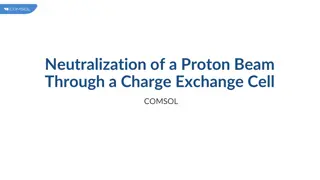Cryogenic Gas Stopping Cell for High Precision Nuclear Physics Experiments
In the field of nuclear physics, high-quality ion beam parameters are essential for both primary and secondary beams. This report focuses on the cryogenic gas stopping cell, also known as a gas catcher, designed to transform rare ion beams from nuclear reactions into low-energy beams with small emittance and energy spread. The cell operates at temperatures below 40K and plays a crucial role in enhancing the quality of ion beams for modern experiments. The presentation covers details of the cell construction, working gas quality analysis, and the importance of ion beam quality in nuclear research.
Download Presentation

Please find below an Image/Link to download the presentation.
The content on the website is provided AS IS for your information and personal use only. It may not be sold, licensed, or shared on other websites without obtaining consent from the author. Download presentation by click this link. If you encounter any issues during the download, it is possible that the publisher has removed the file from their server.
E N D
Presentation Transcript
Residual gas analysis in the vacuum at the cryogenic gas stopping cell Novoselov A.S. Sector 4 FLNR JINR Alushta-2023
Plan of the presentation Quadrupole mass spectrometer Cryogenic gas stopping cell Residual gas analysis Introduction Summary 2
Introduction Modern high precision experiments in nuclear physics are require high quality ion beam parameters. And this is true both for primary and secondary beams. This report contains some information about the cryogenic gas stopping cell for secondary beams also known as gas catcher . This setup now is under constuction and testing at the Flerov laboratory of nuclear reactions at the Joint institute for nuclear research. The presentation is dedicated to working gas quality analysis. 3
Cryogenic gas stopping cell Entrance window DC cage RF funnel Extraction nozzle Extraction RFQ Fig. 1. Cryogenic gas stopping cell at the FLNR JINR. The aim of the cryogenic gas stopping cell is the transformation of rare ion beams produced in nuclear reactions from high energy with large emittance into low-energy beams with small emittance and low energy spread. The working temperature of the cold chamber <40K. 4
Cryogenic gas stopping cell Table 1. Atmosphere gases properties Tm, K 63,13 Tb, K 77,33 %, atm 1 Nitogen (N2) Oxygen (O2) CO2 CO 78,1 2 54,35 90,17 20,9 3 216,5 194,6 0,03 4 68,12 81,64 1E-5 5 Argon (Ar) 83,84 87,24 0,934 6 Hydrogen (H2) Neon (Ne) 13,95 20,37 5E-4 7 24,62 27,21 2E-3 8 Krypton (Kr) 115,44 119,92 1E-4 9 Xenon (Xe) 161,29 165,18 9E-6 10 CH4 11 Helium (He) 90,65 111,56 2E-4 1,74 4,206 5E-4 Fig. 2. Ultra high purity helium 7.0 5
Quadrupole mass spectrometer Fig. 3. Pfeiffer Vacuum PrismaPro QMG 250 M3 is a quadrupole mass spectrometer for quantitative gas analysis. qualitative and A. Ion formation in the ion source from electron impact ionization 1. Ion optic 2. Formation area 3. Filament Ion separation according to the mass-to-charge ratio Ion detection B. C. Fig. 4. Principle of the quadrupole mass spectrometer 6
Quadrupole mass spectrometer Pfeiffer Vacuum PrismaPro QMG 250 M3 technical parameters: Detector type: EM/Faraday Mass range: 1-300 u Connection flange: DN 40CF Vacuum required (max pressure): <3,75 10-4Torr Detection limit (EM): 3,75 10-15Torr Sensitivity (Faraday): >2,25 10-4A/Torr Operating temperatures: Analyzer: 150 0C QME: 5 to 50 0C Interfaces: Ethernet D-Sub (relay output, analog input, digital input, +24V output) Software: PV MassSpec 7
Scheme of the experiment Obtain UHV conditions at the PrismaPro Obtain HV conditions at the cold chamber Obtain temperature below 40K at the cold chamber Scan m/z spectrum as reference Open dosing valve to scan m/z spectrum probe from the cold chamber Compare two scans Fig. 5. Simplified scheme of the gas analysis using PrismaPro mass spectrometer 8
Residual gas analysis Background (mass spectrometer volume) Backgroung (mass spectrometer volume) H+ N+ 2 (CO+) 2 N+ 1E-10 1E-10 O+ O+ 2 H2O+ N2+ C+ Signal (Amp) Signal (Amp) 1E-11 1E-11 He+ CO+ O2+ 2 Ar+ Ar2+(Ne+) 1E-12 1E-12 1E-13 1E-13 1E-14 1E-14 0 10 20 30 40 50 0 50 100 150 200 250 300 m/z m/z Fig. 6. Example of the m/z spectrum from the PrismaPro vacuum volume. Total pressure ~1,8E-10Torr. Dosing valve from cold chamber closed. 9
Residual gas analysis Helium in the cold chamber with background He+ 1E-08 1E-09 Signal (Amp) 1E-10 H+ 2 N+ 2 (CO+) 1E-11 H2O+ O+ O+ 2 CO+ N+ 2 Ar+ C+ Ar2+(Ne+) 1E-12 0 10 20 30 40 50 m/z Fig. 7. Example of the m/z spectrum from the PrismaPro and the cold chamber vacuum volume. Total pressure ~1,4E-5Torr. 10
Summary The working cryogenic temperature and gas pressure at the cold chamber in the standalone mode are reached. The first results of the residual gas analysis at the cryogenic gas stopping cell are show that helium quality is enough high for the using it as working gas. The quantity of impurities are lower relative to reference m/z spectrum which was done at ultra high vacuum area. For the future plans concerning to helium it is needed to measure gas parameters at the flow mode. 11


